Off the beaten track, and yet still within striking distance of Bari airport, Conversano’s relaxed atmosphere offers a peaceful and easy break. Jane Gifford flies down to Puglia…
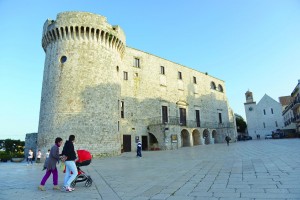 It’s early evening in the centro storico, the historical centre of the ancient little walled town of Conversano in the Bari district of Puglia. The town is built on a gentle hill. At its summit, in the centre of a broad square, a gleaming white limestone fortress catches the last light of the sinking sun. Shadows slide over the surrounding buildings. The square is paved with limestone slabs that have been polished to a high shine by countless feet. There is a slightly disorientating slope upwards towards the old cathedral. Lights are coming on in cafés and bars. People stand chatting in groups. Floodlights turn on and the castle glows golden beneath a pink-flushed sky. It’s a lovely scene and a perfect start to any short break in this part of Italy.
It’s early evening in the centro storico, the historical centre of the ancient little walled town of Conversano in the Bari district of Puglia. The town is built on a gentle hill. At its summit, in the centre of a broad square, a gleaming white limestone fortress catches the last light of the sinking sun. Shadows slide over the surrounding buildings. The square is paved with limestone slabs that have been polished to a high shine by countless feet. There is a slightly disorientating slope upwards towards the old cathedral. Lights are coming on in cafés and bars. People stand chatting in groups. Floodlights turn on and the castle glows golden beneath a pink-flushed sky. It’s a lovely scene and a perfect start to any short break in this part of Italy.
Taking a seat on the square outside Pashà restaurant and café, I watch the crowds gather to enjoy this beautiful evening and relish the moment over a spritz, Italy’s favourite cocktail – a healthy shot of Aperol over ice in a large glass of Prosecco, served here in Conversano with carrot crudités and a large bowl of taralli, a local speciality: crunchy and delicious biscuit rings made with flour, oil and wine. I am a new face in town so friendly locals immediately engage me in conversation. “The weather’s fine all weekend, you must see Polignano a Mare.” “Don’t miss our beautiful churches here in Conversano.” “You have to try Pashà’s ice cream.” I order two scoops, one almond, one pistachio. Delicious. Most cafés and restaurants here pride themselves on making their own ice-cream. You will seldom be disappointed. “Try the granite di limone at Bar Torrione. It’s the best in town,” somebody adds.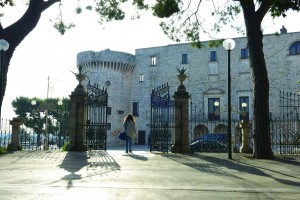
Overwhelmed with suggestions of what to see and do, I walk around the cathedral to Hotel Corte Altavilla, just moments away in the medieval backstreets in the heart of the old town. The hotel is itself a converted medieval court. The entrance is directly opposite the intricately carved main entrance to Conversano’s Romanesque cathedral, which dates back to the 11th century. Damaged by fire in 1911, the cathedral has been restored inside and recently underwent a major cleaning outside. Now it is once more gleaming white. Almost everything in the old centre is built of white limestone, a distinguishing characteristic of Puglian architecture. Generally the old town is closed to traffic. I have left my car in the pay-and-display car park nearby. “No,” says the hotel receptionist. “No need to pay. Just park on the forecourt of any petrol station. There are two across the road.” I check with the garage attendant. “Ma certo, signora. It’s what everybody does.” He even moves a display stand right outside the kiosk so that I can fit in easily. And with that simple gesture all my parking problems are solved.
The railway station is only a short walk away from the old town so, even without a car, surrounding attractions, as well as Bari airport, are easily accessible. There is a decent bus service and most hotels have bicycles for guests to use. Since the immediate countryside is generally flat, this is a pleasant way to get about. Take a tour of the cherry orchards surrounding Conversano. Meander through olive groves down to the sea or head off towards the Istrian Valley and amuse yourself by playing ‘Spot the Trulli’.
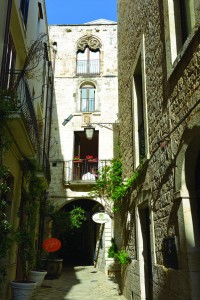 Conversano is a little gem unspoilt by mass tourism and an ideal place to experience an authentic sample of Puglian life. The medieval centre is remarkably unspoilt by modern development and one of Puglia’s most beautiful beaches is only a few kilometres away. Up early, I join the dog-walkers and older residents for a turn around the old town before breakfast. You can see the Adriatic from Piazza Castello. The air is bright and clear and there is a light breeze off the sea. By 7am the cafés are already filling with regulars. Students from the college across the road favour Della Corte on Piazza Conciliazione, which is a continuation of the main square around the back of the castle. It’s the most inexpensive of the bars and always lively. Those who want the best view or to read a newspaper in peace choose Pashà.
Conversano is a little gem unspoilt by mass tourism and an ideal place to experience an authentic sample of Puglian life. The medieval centre is remarkably unspoilt by modern development and one of Puglia’s most beautiful beaches is only a few kilometres away. Up early, I join the dog-walkers and older residents for a turn around the old town before breakfast. You can see the Adriatic from Piazza Castello. The air is bright and clear and there is a light breeze off the sea. By 7am the cafés are already filling with regulars. Students from the college across the road favour Della Corte on Piazza Conciliazione, which is a continuation of the main square around the back of the castle. It’s the most inexpensive of the bars and always lively. Those who want the best view or to read a newspaper in peace choose Pashà.
After breakfast I head down via San Mauro towards the three-tiered tower of Conversano’s Benedictine Monastery, which was founded on an ancient crypt dedicated to San Mauro in the 6th century. Bright yellow and blue majolica tiles on the tower’s domed roof, and on a much larger dome behind it, gleam in the morning sun. This was once the most important monastery in Puglia. In the 13th century it was given by the Pope to Cistercian nuns, who were remarkable in being the only female order in western Europe allowed to wear male religious symbols. The Civic Museum is housed in the impressively restored rooms of the monastery. Nearby, below the castle walls, within a little courtyard sheltered by awnings, is Caffè 7000. It’s a great spot for coffee, juices and a variety of excellent quality snacks. Being off the main drag it’s even more reasonably priced than the other bars, none of which are expensive. Back on Piazza Castello the sound of music announces the approach of Conversano’s famous band, who march across the square carrying Trade Union banners. (Well, it’s more of a casual swagger than a march. This is southern Italy!) The tradition dates back to 1832.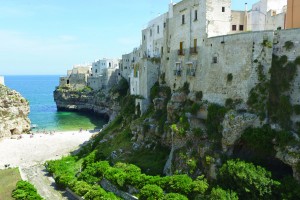
Conversano Castle was built by the Normans. The town, then known as Norba, was the capital of a large county under the rule of Altavilla. The castle was inherited 1456 by Caterina Orsini Del Balzo. She and her husband, Giulio Antonio, started the long line of the Counts of Acquaviva who resided here until 1806 when the decree of Giuseppe Bonaparte led to the abolition of feudal power in Puglia. Giangirolamo II (1626-1665) known as the ‘Squint-Eyed’ Count, was an important patron of the arts. He sponsored Paolo Finoglio, whose cycle of paintings ‘Jerusalem Delivered’ can be seen in the castle museum. Finoglio also painted the frescoes in the Church of Saints Cosma and Damiano on the opposite side of the old town from the castle. They are prized amongst the finest examples of Neapolitan baroque in Puglia. Count Squint-Eye is mainly remembered for his cruelty: he had 12 priests from nearby Narbo executed simply for criticising his rule. He was also a stickler for strict adherence to the ‘droit de seigneur’, which obliged every bride to spend her wedding night with him. Conversanesi have been known as the ‘Sons of the Count’ ever since.
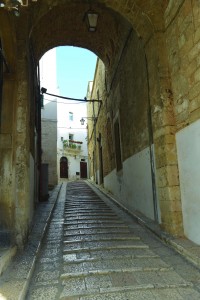 The little road to Polignano a Mare runs straight as a die between villas and olive groves down to the coast. Polignano is remarkable for its cliffs and caves. The coast-line here is relatively flat, distinguished only by the extraordinary colour of the water. First stop is the life-size bronze of singer Domenico Modugno on the cliff-top esplanade to the north of the pretty pebble beach. There is an excellent view from here of the bright white buildings of the old town clustered along the headland to the south with the intense blue of the Adriatic stretching off to the horizon. Domenico, who was born here in 1928, became an international star with his famous hit Nel blu dipinto di blu, better known as Volare. The song remains popular – Virgin Airlines recently used the Dean Martin version for their TV commercial. Puglia’s most famous modern artist, sculptor Pino Pascali, was also born here in 1935. There is a Museum of Modern Art on Parco del Lauro dedicated to him. Famous for its dramatic location, Cala Paura Beach is in an almost circular bay hemmed in by cliffs. It’s a great spot for a swim or a little sun-bathing. The beach is approached though gardens down a ravine which passes under the main road. There is another great view from the bridge. There are pleasant bars and restaurants on the little Piazza dell’Orologio in the old town. Leave time to visit Mario Campanella’s ‘Super Mago del Gelo’ on Piazza Garibaldi in the more modern part of town. Established 1935, a venerable institution serving heavenly ice-creams as well as fancy coffees, crushed ice drinks and liqueurs.
The little road to Polignano a Mare runs straight as a die between villas and olive groves down to the coast. Polignano is remarkable for its cliffs and caves. The coast-line here is relatively flat, distinguished only by the extraordinary colour of the water. First stop is the life-size bronze of singer Domenico Modugno on the cliff-top esplanade to the north of the pretty pebble beach. There is an excellent view from here of the bright white buildings of the old town clustered along the headland to the south with the intense blue of the Adriatic stretching off to the horizon. Domenico, who was born here in 1928, became an international star with his famous hit Nel blu dipinto di blu, better known as Volare. The song remains popular – Virgin Airlines recently used the Dean Martin version for their TV commercial. Puglia’s most famous modern artist, sculptor Pino Pascali, was also born here in 1935. There is a Museum of Modern Art on Parco del Lauro dedicated to him. Famous for its dramatic location, Cala Paura Beach is in an almost circular bay hemmed in by cliffs. It’s a great spot for a swim or a little sun-bathing. The beach is approached though gardens down a ravine which passes under the main road. There is another great view from the bridge. There are pleasant bars and restaurants on the little Piazza dell’Orologio in the old town. Leave time to visit Mario Campanella’s ‘Super Mago del Gelo’ on Piazza Garibaldi in the more modern part of town. Established 1935, a venerable institution serving heavenly ice-creams as well as fancy coffees, crushed ice drinks and liqueurs.
For Jane’s tips on where to stay, where to eat and what to see and do, click here.
Images © Jane Gifford
